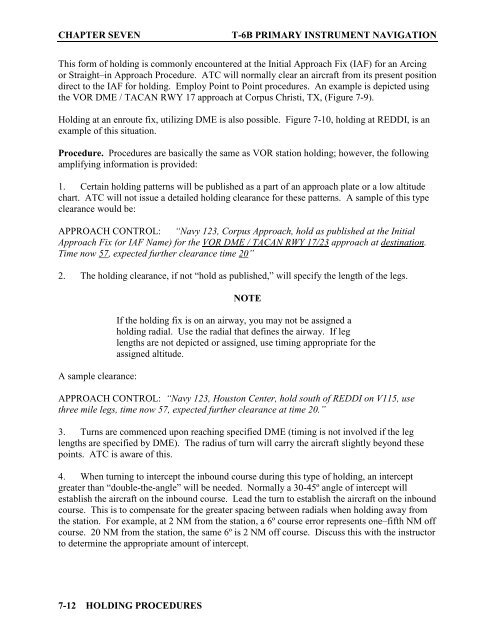Flight Training Instruction - Cnatra - U.S. Navy
Flight Training Instruction - Cnatra - U.S. Navy
Flight Training Instruction - Cnatra - U.S. Navy
You also want an ePaper? Increase the reach of your titles
YUMPU automatically turns print PDFs into web optimized ePapers that Google loves.
CHAPTER SEVEN T-6B PRIMARY INSTRUMENT NAVIGATION<br />
This form of holding is commonly encountered at the Initial Approach Fix (IAF) for an Arcing<br />
or Straight–in Approach Procedure. ATC will normally clear an aircraft from its present position<br />
direct to the IAF for holding. Employ Point to Point procedures. An example is depicted using<br />
the VOR DME / TACAN RWY 17 approach at Corpus Christi, TX, (Figure 7-9).<br />
Holding at an enroute fix, utilizing DME is also possible. Figure 7-10, holding at REDDI, is an<br />
example of this situation.<br />
Procedure. Procedures are basically the same as VOR station holding; however, the following<br />
amplifying information is provided:<br />
1. Certain holding patterns will be published as a part of an approach plate or a low altitude<br />
chart. ATC will not issue a detailed holding clearance for these patterns. A sample of this type<br />
clearance would be:<br />
APPROACH CONTROL: “<strong>Navy</strong> 123, Corpus Approach, hold as published at the Initial<br />
Approach Fix (or IAF Name) for the VOR DME / TACAN RWY 17/23 approach at destination.<br />
Time now 57, expected further clearance time 20”<br />
2. The holding clearance, if not “hold as published,” will specify the length of the legs.<br />
A sample clearance:<br />
7-12 HOLDING PROCEDURES<br />
NOTE<br />
If the holding fix is on an airway, you may not be assigned a<br />
holding radial. Use the radial that defines the airway. If leg<br />
lengths are not depicted or assigned, use timing appropriate for the<br />
assigned altitude.<br />
APPROACH CONTROL: “<strong>Navy</strong> 123, Houston Center, hold south of REDDI on V115, use<br />
three mile legs, time now 57, expected further clearance at time 20.”<br />
3. Turns are commenced upon reaching specified DME (timing is not involved if the leg<br />
lengths are specified by DME). The radius of turn will carry the aircraft slightly beyond these<br />
points. ATC is aware of this.<br />
4. When turning to intercept the inbound course during this type of holding, an intercept<br />
greater than “double-the-angle” will be needed. Normally a 30-45º angle of intercept will<br />
establish the aircraft on the inbound course. Lead the turn to establish the aircraft on the inbound<br />
course. This is to compensate for the greater spacing between radials when holding away from<br />
the station. For example, at 2 NM from the station, a 6º course error represents one–fifth NM off<br />
course. 20 NM from the station, the same 6º is 2 NM off course. Discuss this with the instructor<br />
to determine the appropriate amount of intercept.
















